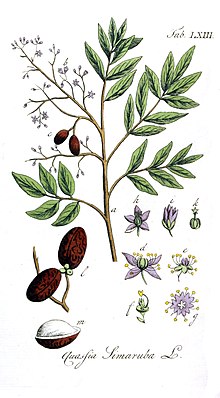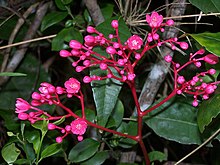| Simarouba | |
|---|---|

| |
| Simarouba amara | |
| Scientific classification | |
| Kingdom: | Plantae |
| Clade: | Tracheophytes |
| Clade: | Angiosperms |
| Clade: | Eudicots |
| Clade: | Rosids |
| Order: | Sapindales |
| Family: | Simaroubaceae |
| Genus: | Simarouba Aubl. 1775 [1] |
| Type species | |
| Simarouba amara | |
| Species | |
|
Simarouba amara | |
Simarouba is a genus of trees and shrubs in the family Simaroubaceae, native to the neotropics. It has been grouped in the subtribe Simaroubina along with the Simaba and Quassia genera. They have compound leaves, with between 1 and 12 pairs of alternate pinnate leaflets. Their flowers are unisexual, relatively small (around 1 cm long) and arranged in large panicles. Plants are dioecious, bearing only male or female flowers.[2] The individual flowers have between 4 and 6 sepals and petals and between 8 and 12 stamens. The fruit is a carpophore and has up to 5 drupaceous mericarps.
In 1944, Adolf Engler and Arthur Cronquist separated the species in the genus,[3] based mainly on the morphology of their flowers, but also using differences in their leaf structure. S. amara, S. glauca and S. versicolor are continental tree species and are often confused with each other, particularly in areas where more than one species is present in the flora. S. amara can be distinguished by having smaller flowers and anthers than S. glauca and S. versicolor and by it having straight, rather than curved petals; its fruit are also smaller. S. glauca can be distinguished by the lack of trichomes on its leaves compared with those of S. versicolor, which has dense tomentose leaves. S. versicolor has a greater variation in flower size than S. glauca and the leaf veins of S. glauca are generally more evident than those of S. versicolor. Geographically, S. glauca and S. versicolor are easy to distinguish since the southerly range of S. glauca is limited to Panama, whereas S. versicolor is only found in South America.[3][4] A phylogenetic analysis in 1995 based on the large sub-unit of rubisco suggested that Simarouba was most closely related to the Leitneria and Ailanthus genera,[5] but a later study in 2007, based on three chloroplastic genes and one nuclear gene,[6] found it was most closely related to Pierreodendron and Simaba.[7]
| Structure | S. amara | S. glauca | S. versicolor |
|---|---|---|---|
| Flower | 3–5 mm long | 4–7.5 mm long | 4–7.5 mm long |
| Anthers | 0.4–1.2 mm long | 1.3–2.0 mm long | 1.0–1.5 mm long |
| Petals | Straight, dull yellow-green to white | Curved, brighter yellow with a touch of orange or red | Curved |
| Fruits | 1.0–1.5 x 0.6–1.0 cm | 2.0–2.5 x 1.2–1.5 cm | 2.0–2.5 x 1.5–2.0 cm |

S. berteroana, S. laevis and S. tulae are endemic to the Caribbean islands.[4]
- ^ Simarouba Aubl. in Hist. Pl. Guiane: 859 (1775), nom. cons.
- ^ Clayton, Joshua William (2008). Evolutionary history of Simaroubaceae (Sapindales): Systematics, biogeography and diversification (PhD). University of Florida.
- ^ a b Cronquist, A. (1944). "Studies in the Simaroubaceae-II. The Genus Simarouba". Bulletin of the Torrey Botanical Club. 71 (3): 226–234. doi:10.2307/2481702. JSTOR 2481702.
- ^ a b Franceschinelli, E. V.; Yamamoto, K.; Shepherd, G. J. (1998). "Distinctions among Three Simarouba Species". Systematic Botany. 23 (4): 479–488. doi:10.2307/2419379. JSTOR 2419379.
- ^ Fernando, E. S.; Gadek, P. A.; Quinn, C. J. (1995). "Simaroubaceae, an Artificial Construct: Evidence from rbcL Sequence Variation". American Journal of Botany. 82 (1): 92–103. doi:10.2307/2445791. JSTOR 2445791.
- ^ Clayton, J.W.; Fernando, E.S.; Soltis, P.S.; Soltis, D.E. (2007). "Molecular phylogeny of the Tree-of-Heaven family (Simaroubaceae) based on chloroplast and nuclear markers". Int. J. Plant Sci. 168 (9): 1325–1339. doi:10.1086/521796.
- ^ Klaus Kubitzki (29 January 2011). Flowering Plants. Eudicots: Sapindales, Cucurbitales, Myrtaceae. Springer. p. 413. ISBN 978-3-642-14396-0. Retrieved 10 January 2011.